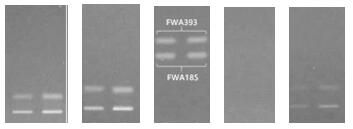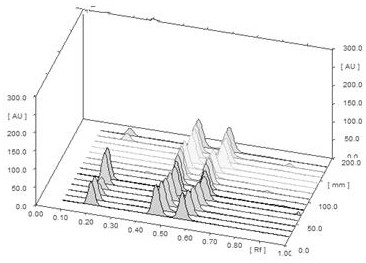A method for rapid screening of fluorescent whitening agents in rice noodle products by high performance thin layer chromatography-mass spectrometry
A technology of high-efficiency thin-layer chromatography and fluorescent whitening agent, which is applied in the direction of instruments, measuring devices, scientific instruments, etc., and can solve the problems of complicated sample preparation steps, low sensitivity and specificity, and expensive analysis costs
- Summary
- Abstract
- Description
- Claims
- Application Information
AI Technical Summary
Problems solved by technology
Method used
Image
Examples
Embodiment 1
[0030] (1) Preparation of FWAs standard solution: use methanol: ethyl acetate = 1:9 as solvent, prepare standard solutions of FWA185 and FWA393 with a concentration of 0.01mg / mL, and then establish a standard curve by diluting the standard solution to 0.001 and 0.0001 mg / mL;
[0031] (2) High-efficiency thin-layer chromatographic separation: 4-8 μL of FWA185 and FWA393 mixed standards, wheat / rice flour and wheat / rice noodle samples were accurately spotted with Linomat 5, and after spotting was completed, the developer solution (toluene: acetic acid Ethyl ester=10:0.3 (v / v)) to unfold, the upward unfolding distance is 50 mm, after the unfolding is completed, take out the silica gel plate and place it on a flat heater at 60°C for 3 minutes to fully dry;
[0032] (3) Scanning and quantification with a thin-layer scanner: place the high-efficiency thin-layer chromatography plate in step (2) in a thin-layer scanner for scanning and quantification. The light source is a mercury lamp...
Embodiment 2
[0036] The specific implementation method is the same as in Example 1, the difference is that the selection of the mobile phase for development, after testing toluene:ethyl acetate=10:0.3 (v / v), the development effect is the best, and then the matrix effect experiment is carried out, using the same proportion of mobile phase. There is no obvious difference in the development effect, indicating that the sample matrix has no obvious interference with the development, and this mobile phase is used for the subsequent development of the standard addition recovery.
Embodiment 3
[0038] (1) Wheat and rice flour and wheat and rice noodles were tested with different spiked amounts.
[0039] Pretreatment of wheat and rice flour and wheat and rice noodles: Add 20 mL of ethyl acetate to 5 g of the sample of wheat and rice flour and chopped wheat and rice noodles, ultrasonically homogenize for 20 minutes, let stand for 5 minutes, and use a 5 mL syringe Aspirate 1 mL of the supernatant, filter it through a 0.45 μm organic membrane, and refrigerate it at 4°C.
[0040] The pretreatment of the sample solution of the recovery rate of the standard addition: add 20 mL of ethyl acetate to 5 g of wheat flour and chopped wheat noodles of the sample, ultrasonically homogenize for 20 min, let stand for 5 min, draw 1 mL of the supernatant with a 5 mL syringe, and Filter through a 0.45 μm organic membrane, add 15 μL 0.01 mg / mL FWA185 to the wheat flour extract, add 10 μL 0.01 mg / mL FWA185 and 10 μL 0.01 mg / mL FWA393 to the wheat noodle extract, and refrigerate at 4 °C.
[...
PUM
 Login to View More
Login to View More Abstract
Description
Claims
Application Information
 Login to View More
Login to View More - R&D
- Intellectual Property
- Life Sciences
- Materials
- Tech Scout
- Unparalleled Data Quality
- Higher Quality Content
- 60% Fewer Hallucinations
Browse by: Latest US Patents, China's latest patents, Technical Efficacy Thesaurus, Application Domain, Technology Topic, Popular Technical Reports.
© 2025 PatSnap. All rights reserved.Legal|Privacy policy|Modern Slavery Act Transparency Statement|Sitemap|About US| Contact US: help@patsnap.com



